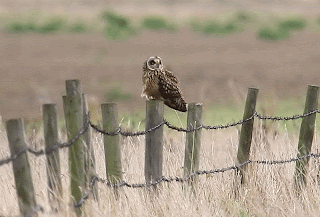This is one of the legendary birdwatching locations in Britain, with a diversity of habitats and being uniquely placed projecting east into the North Sea, Norfolk catches some of the most exciting and inspiring birds the UK has to offer. From the sweeping mud flats and sand dunes of the west via the salt and fresh marshes and fragile cliffs, to the grazing marshes and shallow lakes of the broads in the east. This is one of the best locations in the country to see the most spectacular winter wildlife sights, all within easy reach.
Pink-footed Geese
 |
| Pink-footed Geese (Mick Green) |
The
arrival of tens of thousands of these vocal Arctic geese is the most
awe-inspiring spectacle. Spending their days feeding on farmland
around the county, in the evening long, straggling skeins of a few
hundred at a time will make their way back to the coast and the safety of mud
flats and marshes to roost. The best time and place to see the
impressive scale of this migration is at dawn after a dark, moonless
night at Snettisham on the west-facing end of the coast.
 |
Knot in flight (Mick Green) |
Snow Buntings and
Shore Larks
 |
| Snow Bunting (Mick Green) |
Moving
east to the sand dunes of Thornham, Holkham and Wells and the shingle
ridge from Blakeney Point, Cley and Salthouse more Arctic breeders
can be found. In spite of their bright Naples yellow heads and
throats, Shore Larks are masters of camouflage and so are difficult to
find, especially on shingle, but are well worth the effort. Snow
Buntings are more gregarious and tightly bunched flocks of sixty or
more can be seen in their bouncing flight along the shingle ridge at Salthouse most
years. When on the ground they can be as hard to find as the Shore
Larks, apparently vanishing as they land on the stones. It often
happens that you will notice one and then realise that a dozen or so
more are also there feeding invisibly in full view around it.
 |
| Shore Lark (Mick Green) |
Wildfowl
The
fresh marshes of Cley and Salthouse are a haven for wintering Wigeon,
Teal, Gadwall, Pintail and Brent Geese. The Norfolk Wildlife Trust
reserve at Cley Marshes is one of the best places to get up close to
these species and also get large flocks of Golden Plover and Lapwing
coming in to roost in the evening.
Barn Owls,
Short-eared Owls and Harriers
 |
| Barn Owl (Mick Green) |
 |
| Short-eared Owl (Mick Green) |
Short-eared
Owls are winter migrants that can in some years arrive in large
numbers. It is often worth scanning across heaths, reed beds and
marshes for these large, fierce-eyed birds. In the same habitats and
over farmland in the coastal hinterland look out for Hen and Marsh
Harriers spending the winter in Norfolk.
Bean Geese
One for the connoisseur, these geese are winter visitors in low numbers from northern Europe and Asia. There are two races of these grey geese, the Tundra and the Taiga, their names indicating their favoured breeding grounds. Superficially similar to Pink-footed Geese but with orange on the legs and bill they can be challenging to pick out and often are very mobile making an element of luck important in finding them. They are best observed on open fields and grazing marshes all along the coast and inland at sights around the Broads and East Norfolk rivers like Buckenham and Cantly.
Winter gems
 |
| Lapland Bunting (Mick Green) |
The
great joy of birdwatching is the unexpected, and anywhere along the
coast you stand a good chance of turning up something out of the
ordinary. The best way to increase your chances is to tap into the
local knowledge and reports and ask the perennial question of birders
everywhere, “Much about?”.
Some
of the best sources of Norfolk wildlife information on the internet
are listed below.
Cley Spy.
The largest dedicated optics shop in the UK with 200 models of binoculars and over 50 models of telescope in stock plus a good range of second hand optics. We also stock tripods, bird food, straps, Tilley hats and Paramo and Jack Pyke outdoor clothing.
Local
Birder who regularly blogs on the birding scene in Norfolk with
highlights of the days bird news from RBA. This blog is valuable
sources of up-to-date information and photos.
A subscription bird news service with online and pager news sent out 24/7.
Online bird news service with free to access overview of UK bird sighting or subscribe for full details.
Lots of information and photos from the Cley area.
Norfolk wildlife photographer and member of the Cley Spy team.
A group of young, mainly Norfolk based birders with a unconventional outlook on the birding scene.

No comments:
Post a Comment